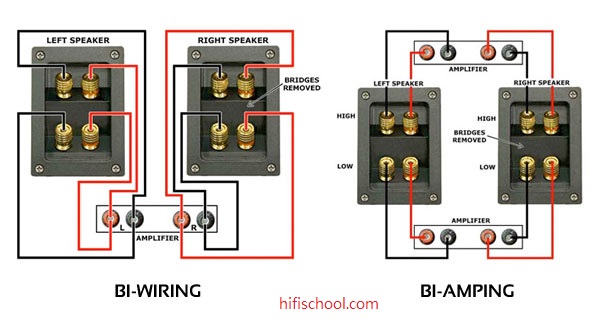We’ve been here before, but while the benefits of biwiring are understood, the practicalities still baffle many readers?
Yes, we know we’ve already covered biwiring your speakers, but the volume of traffic on the chat page of our website suggests many readers are still confused. So we’ve decided to revisit the subject, and answer some of the questions that have arisen.
Biwiring involves the use of two runs of cable between an amp and a pair biwirable speaker. It generally performs better because the isolation of different ranges of sound and relevant signals will go the right place directly.
[adinserter block=”3″]
Therefore, the treble and mid/bass are kept separately right from the speaker outputs of the amp to the speakers. As a result, in general, sound is performed with better bass control and punch, and a clear treble with more details.
Let’s plug your speakers with your amp. If there are 2 sets of speaker outputs in your amp, things will become easy. For this case, there is no different for the amp connecting with a single pair of cables. However, there is no need to worry about connecting 2 sets of cable into 1 pair of terminals on your amp.
OK, so down to the practicalities. If your amp has two sets of speaker outputs, biwiring becomes simpler – no need to cram two sets of thick wire into a single set of terminals. Don’t worry about sections in the manual about limitations when both sets of terminals are used – these only apply when you are actually using two pairs of speakers. Connecting one pair of speakers using both sets of terminals means the amp’s output devices are only ‘seeing’ the same impedance as when you connect with a single pair of cables, so it’s no problem.
In the biwirable speaker boxes, the two halves of the crossover – the circuitboard that takes bass frequencies out of the feed to the treble drive unit, and vice versa – is physically split into two sections.

Bi-wiring & Bi-Amping Example
If your amp can drive your speakers, it can drive them biwired. But the speakers need to be designed to be biwired. In a biwirable speaker, the two halves of the crossover – the circuitboard that takes bass frequencies out of the feed to the treble drive unit, and vice versa – is physically split into two sections. One filters out low frequencies from the feed to the tweeter, the other loses the squeaky stuff from the terminals connected to the mid/bass woofer unit.
If you are single-wiring a biwirable speaker with the link bars in place, experiment with using the upper or lower terminals – there’s often a subtle change in the sound. That’s why some people use speaker cables to replace the bars.
What type of cables should I choose? There used to be a belief that a thin wire was best for the treble leg of biwire set-up but a thicker cable used for the mid/bass side. I also believe this and I love using sliver cables like Cello.
For the first step, the best starting point is the use of the same cable on both legs for the consistent style of sound. You may want to have very stylish cables for listening like Cello Sliver Cable or Monster Elephant trunks.
All in all, nearly all system will be fruitful with biwiring. My experience is very positive. Nevertheless, if there is nothing different during listening, you can save yourself from double your speaker cable.